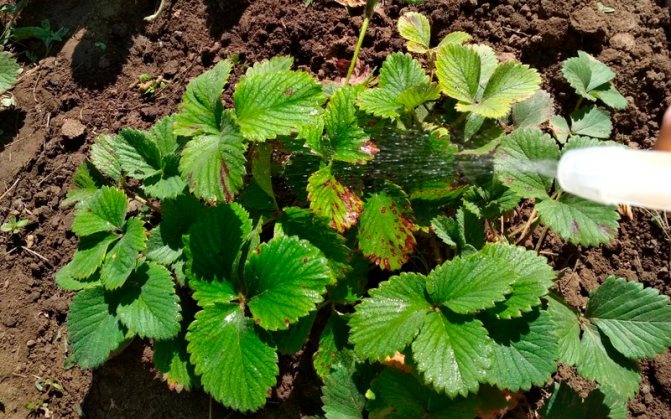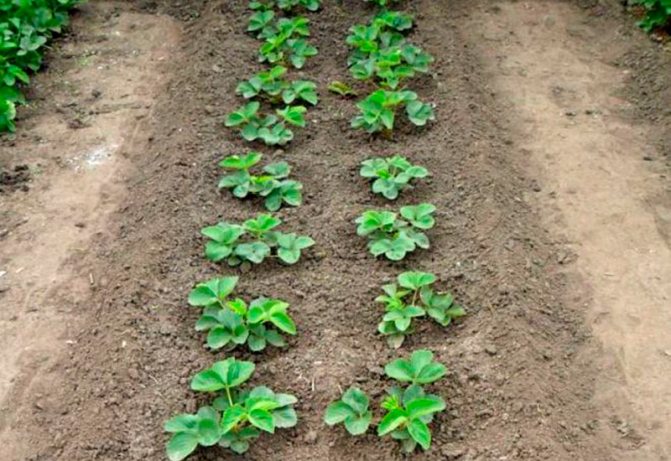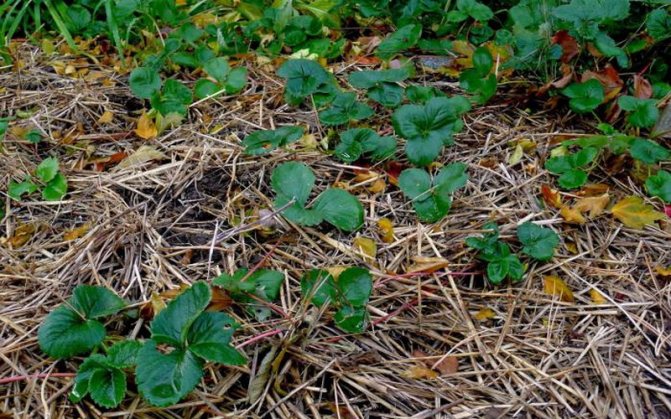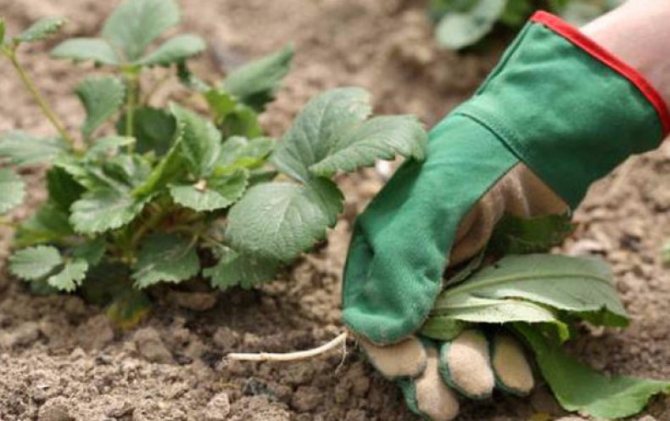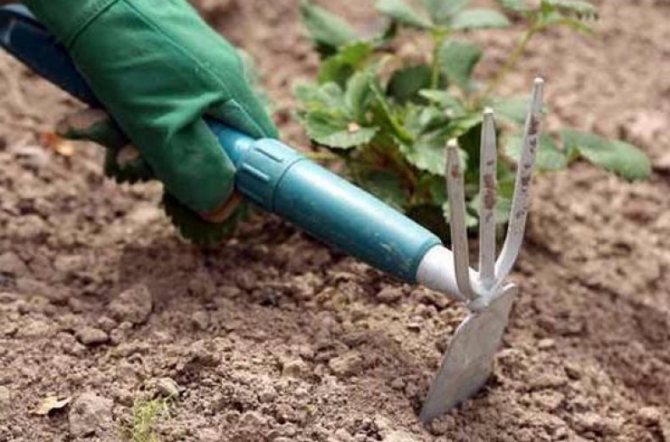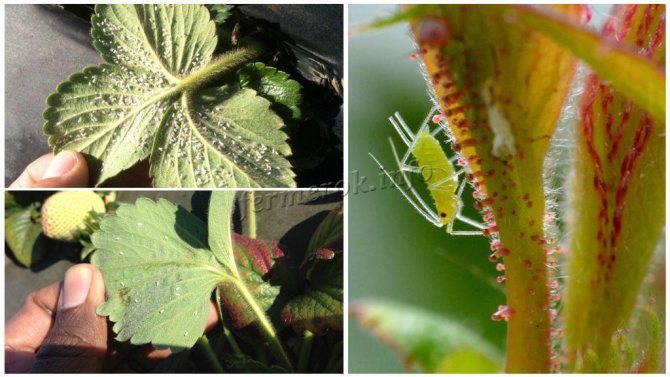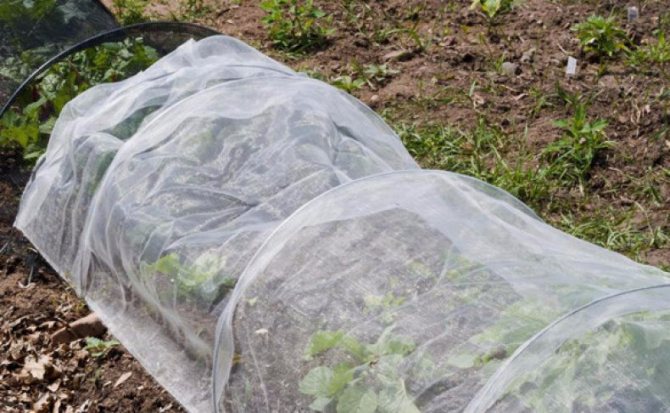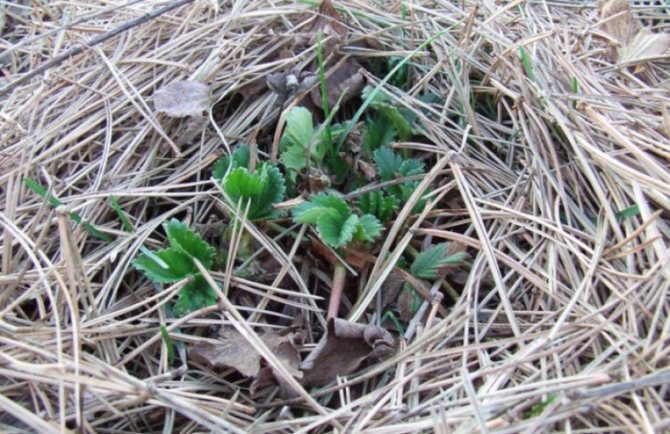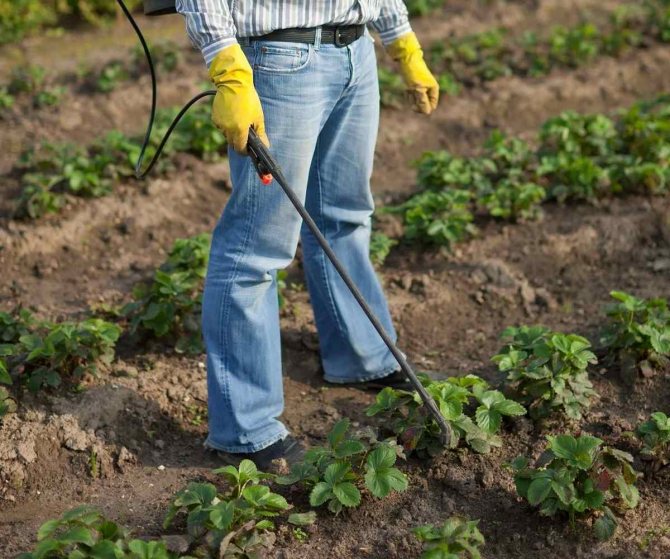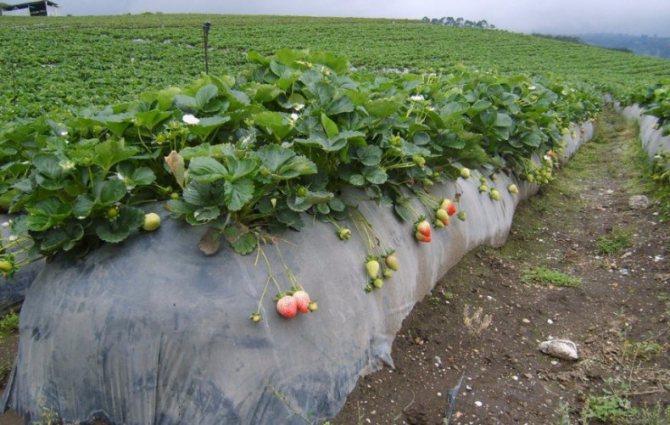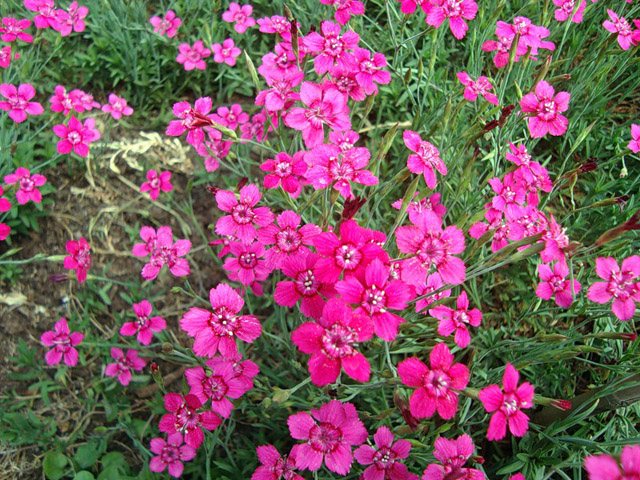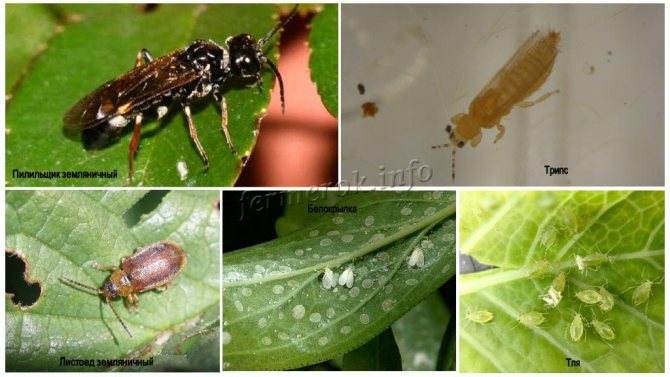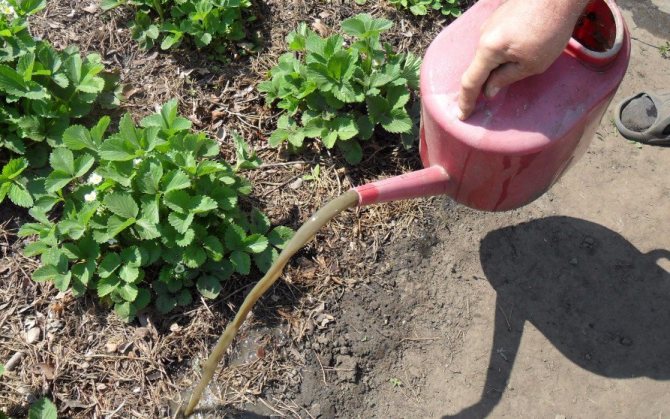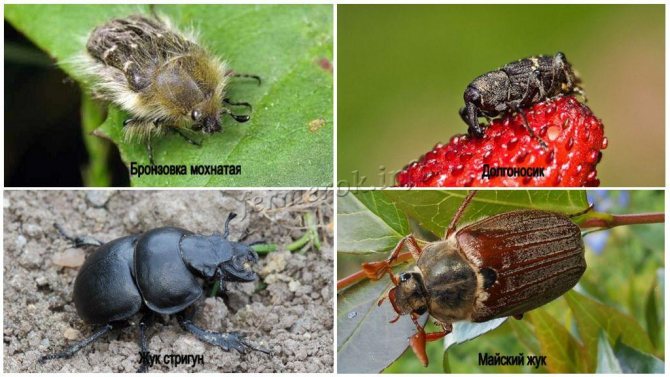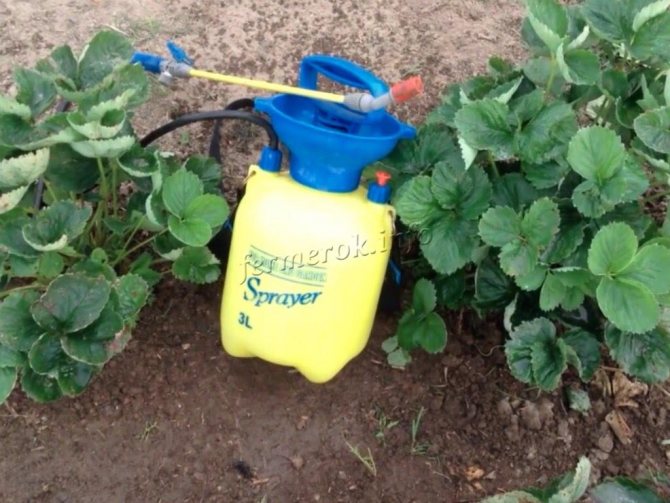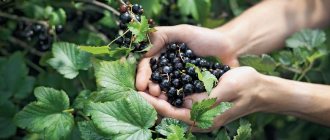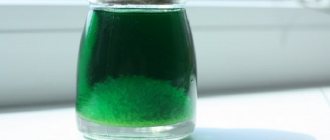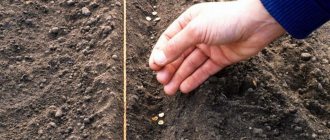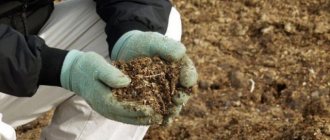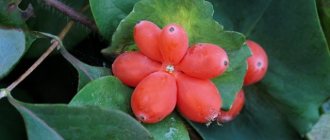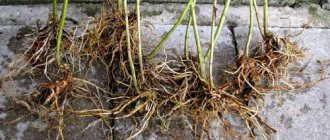Garden strawberries are extremely tasty, but easily susceptible to disease and pest attacks. To please the harvest next summer, Victoria needs to be processed in the fall. Many gardeners prefer to do this in the spring, but they make a mistake. Why processing strawberries in the fall from pests and diseases is important and how to do it, we will tell in our article.
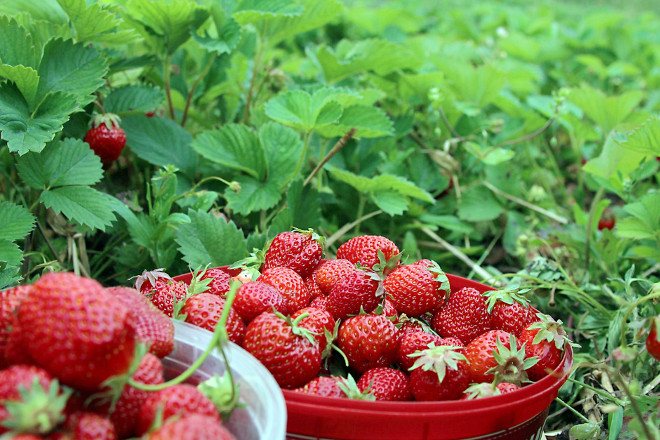
Repairing strawberry varieties are more susceptible to diseases than other types of berry bushes. They must be treated with chemicals, folk remedies 2 times a year: in spring and before hibernation. The rest of the varieties are only in August-September.
Pruning bushes
Experts argue which is better: trim the leaves from strawberry bushes in the winter or not. There are quite a few reasons to do this operation in the fall:
- Pests overwinter in old leaves, which in spring will quickly populate plants in the garden.
- Leaves are a place of accumulation of pathogens of infectious diseases.
- When in contact with wet soil, the leaves quickly rot, becoming a dangerous factor of infection with rot of the entire plant.
- Plants with fewer leaves are easier to cover.
Along with this, there are good reasons not to prune strawberry bushes:
- When pruning leaves, many wounds remain on the bushes, especially when a large amount of green mass is removed. Wound surfaces serve as entry gates for infections.
- With the maximum removal of leaves, the strawberry bush is under severe stress, which is not very good when preparing for wintering. In addition, the plant will urgently try to restore the leaf cover, it will spend its last energy on growing new foliage.
- If the leaves are inaccurately removed, the heart of the bush is often damaged, such a plant can die in the winter.
A very interesting option is partial pruning of the strawberry bush, when the oldest and damaged leaves are removed. It is not recommended to detach them from the bush by hand; it is best to carefully cut off the cuttings of the leaves with sharp scissors that do not wrinkle the leaf tissue. The diseased leaves are burned, otherwise an infectious focus may appear on the berry plantation next year.
Sometimes rooted whiskers remain next to the bushes. You can not remove young plants from the garden until spring, when they are transplanted into a separate garden. Overwintered rooted rosettes are more resistant to bad weather, bloom faster and give a full harvest.
Application of perforated foil
Another way is to cover the strawberries with perforated foil. This material protects strawberries from freezing, accelerates their growth and yield the next year. However, this product overheats the plants, which may affect the yield.
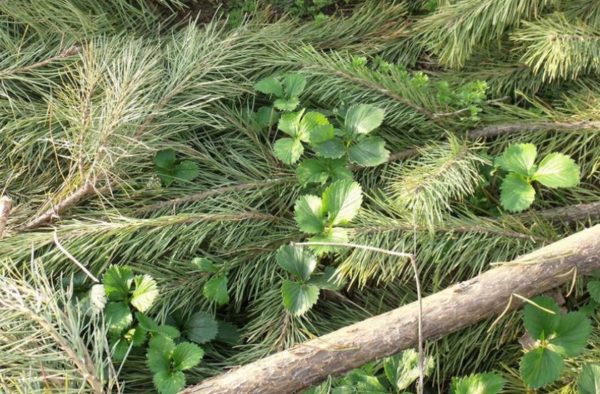

Perforated foil keeps the substrate moist at all times, but in many cases prevents proper air exchange, leading to the development of gray mold. A foil thickness of 0.1 mm is enough to ensure a comfortable wintering. If stored properly, it can last for several seasons.
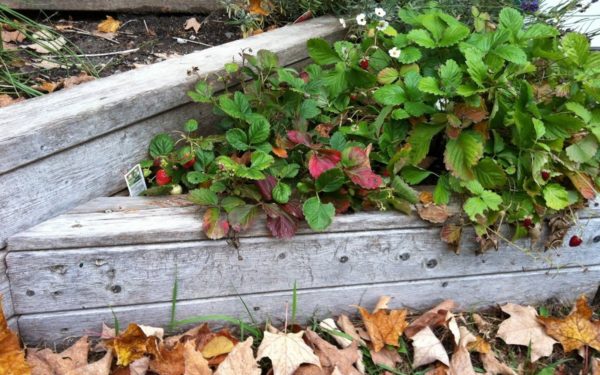

Pruning
Thickened strawberry bushes must be thinned out before winter, and mustaches that are actively formed after fruiting must be removed. The healthiest and strongest shoots can be used as planting material.The mustache is removed because it absorbs moisture and nutrients to the detriment of the mother plant. They are cut with a knife or scissors as close to the ground as possible.
Thinning and trimming of the mustache is done in August - September. Excess bushes are removed so that the distance between the plants is at least 20-25 cm, while it is advisable to create rows of strawberries in order to facilitate subsequent care and picking of berries.
Some gardeners believe that pruning strawberry leaves for the winter is not necessary, just removing old, diseased and damaged leaves is enough. In areas with a large snow cover, this measure is justified, since the snow that fell in late autumn presses the strawberry leaves to the ground, creating a natural insulating layer to protect the roots from frost. Where winters have little snow and the snow cover is formed late, additional measures are required to protect the berries. The alternation of warm and cold weather in autumn, heavy rains increase the likelihood of rotting of strawberry leaves left before winter. This can lead to damage to the berry, mold, rot and other diseases.
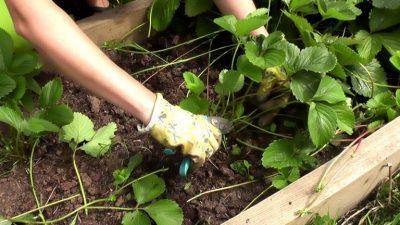

When pruning plants, the following factor must be taken into account: the removal of leaves stimulates the beginning of a new vegetative cycle. If warm weather sets in in the fall, then after pruning all the forces of the plants will be directed to the formation of new foliage. As a result, the strawberries will be weakened and will endure the winter worse.
But even if all the foliage remains before winter, it is necessary to check each bush of plants, be sure to remove and destroy diseased leaves.
Complete mowing of leaves allows you to improve the berry, since many diseases and pests of strawberries and strawberries damage the leafy part of plants. When pruning leaves, care must be taken not to damage the lower parts of the rosettes of the plants and do not pull out the roots. This is best done with sharp scissors or pruning shears.
Fertilizing strawberries before winter
The last dressing is applied under the strawberries in the summer, after mowing the leaves. This is usually done before the end of July and no later than mid-August. Cut strawberries have increased nutritional requirements due to the need to regenerate the green parts.
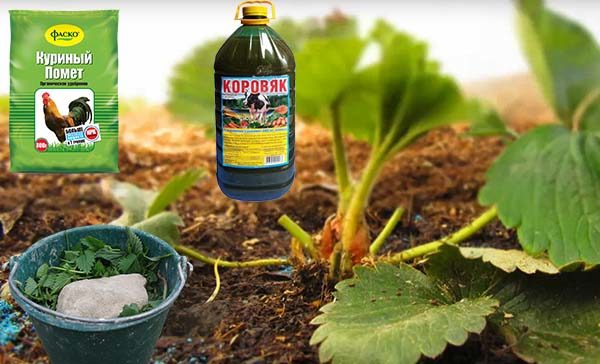

That is why plants are fertilized with a universal compound fertilizer rich in nitrogen (for example, Azofoskaya) or a specialized compound fertilizer for strawberries. In the case of Azofoska, 1 kg of fertilizer is enough for 100 m² of strawberry crops.
Important!
Special fertilizers for strawberries are dosed in accordance with the instructions on the package.
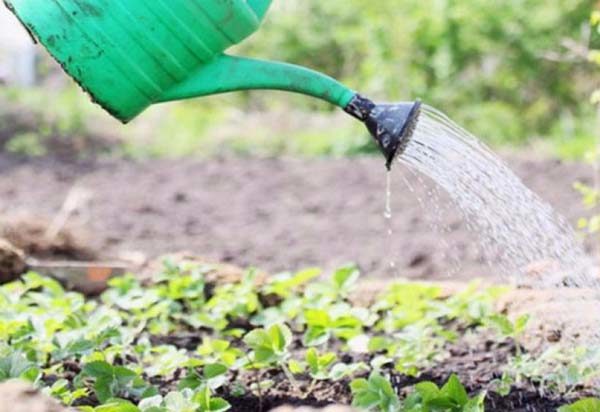

Later, no nitrogen fertilization is given anymore, because it will overstimulate the growth of the strawberry and make it difficult to winter. It is possible to use special autumn fertilizers that do not contain nitrogen, but are rich in phosphorus, potassium (thickens the cell sap before winter), calcium (makes the cell walls more flexible), sulfur (disinfects and stimulates the conversion of nitrogen into proteins) and trace elements such as:
- boron;
- zinc;
- manganese.
Applying these fertilizers in the fall will make it easier for the strawberries to winter. In practice, however, it is usually not necessary to feed the strawberries so intensively.
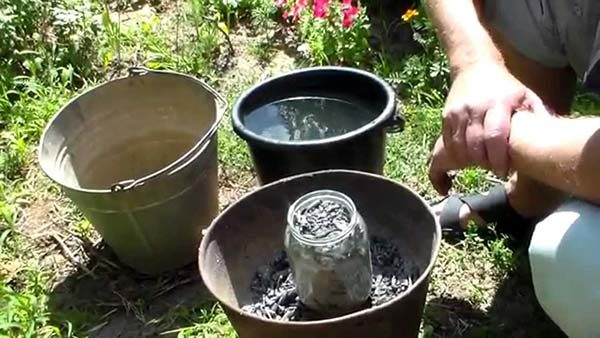

It is worth applying fertilizers in the fall only if signs of a lack of these components were noted during the growing season, such as:
- discoloration of dark pigment on strawberry leaves, indicating a lack of phosphorus;
- dryness of the edges of young leaves and their deformation, which can be the result of calcium deficiency.
At the same time, fertilizing strawberries has a very large effect on plant growth. It provides a good harvest and delicious berry taste.
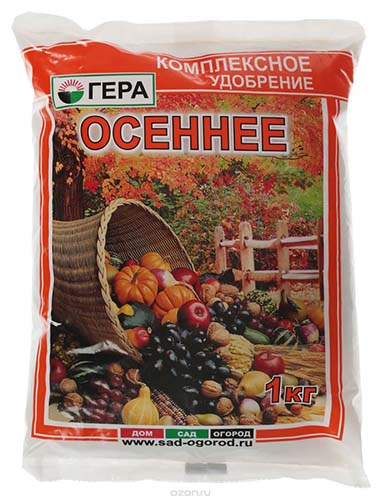

Popular varieties
There are varieties of remontant strawberries without whiskers, which save gardeners time and space; there are varieties with a mustache that are more resistant to heat and drought.
- Albion.The variety has powerful bushes, the berries are large, dark red, have an oblong shape. This variety gives a rich harvest, it is resistant to diseases, the berries are easy to transport without damage. Possesses average frost resistance. Fruiting in spring, summer and mid-September.
- Queen Elizabeth. Low-grade variety. Some berries reach 100 grams, they are dark crimson, very juicy and fragrant. The culture tolerates winter well, disease resistant. The whole season pleases with juicy berries.
- Lyubava. On small bushes, oval-shaped red berries ripen. The variety is winter-hardy, almost does not suffer from pests.
- Selva. Berries are fragrant, very large, regular shape. The variety has a high yield, almost does not get sick. Resistant to winter. But it is necessary to properly care for Selva, otherwise the berries will become small.
- Vima Rina. Ideal for dry areas. It tolerates heat well, the berries are large, sweet and sour.
- Mahern. The advantages of the variety are tasty medium-sized berries, high yield. Can bear fruit in the shade.
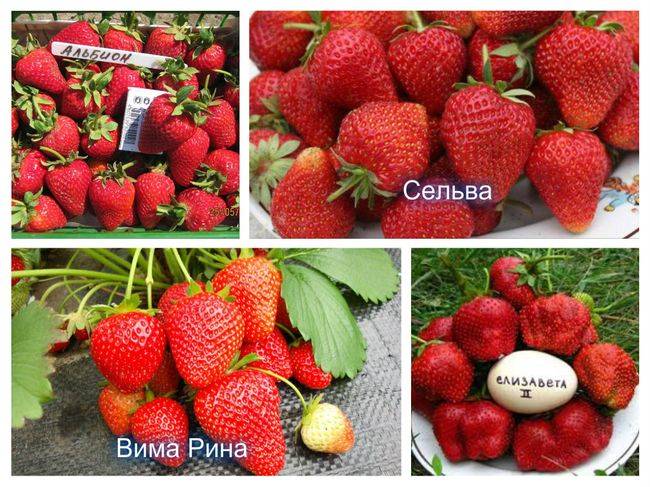

Autumn transplant
For transplanting, take one- or two-year-old bushes, previously divided into parts. You can also use the growth formed on the antennae. The transplant is performed primarily with the aim of rejuvenating the planting. For 3-4 years, berry bushes age, the number of flower stalks decreases, and the berries themselves become smaller.
Strawberry transplantation is carried out in the fall, since during this period the soil is more humid and warmer, and the weather is cool. Start replanting bushes in mid-August and finish in the first weeks of September. This gives the plant time to take root, take root and grow a good green mass.
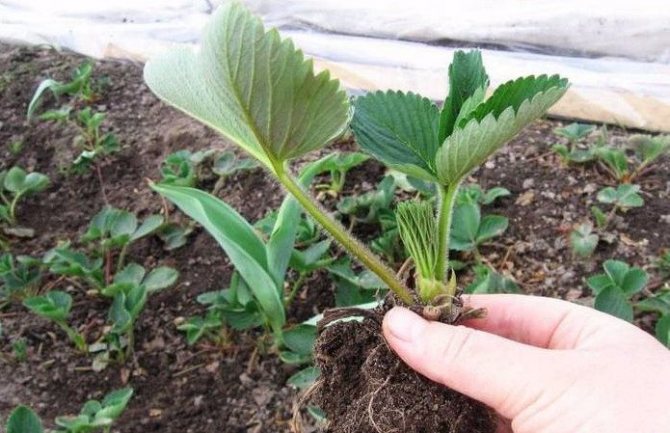

Towards winter, the strawberries will go strong and dressed in lush foliage. Most of the seedlings transplanted during this period easily tolerate the winter, and begin to bloom in the spring. Thus, an autumn transplant is the best answer to the question of how to prepare strawberries for winter.
However, there is some risk in the fall transplant: too early frosts can reduce the number of rooted seedlings. In addition, a snowless winter can destroy transplanted bushes.
Important! Remember that strawberries are not transplanted before winter, when the ground has already been frozen. If you did not have time to transplant the bushes in early autumn, before the frost, it is better to postpone this procedure until the spring.
Step by step transplant:
- Choose a nutrient-rich, lit area for your seedlings.
- Prepare the beds - loosen the soil, apply organic fertilizers.
- Form small holes (the distance between the holes should be approximately 35-40 cm).
- Pour water over the wells. Immediately plant two young bushes in wet soil at once (at least one of the two seedlings will certainly take root). Do not plant the seedlings too deep. The growth point of each seedling (the area from which the leaves extend) should be level with the ground.
- Sprinkle soil over the roots. Apply lightly so that the soil is firmly attached to the rhizome.
Did you know? Strawberry is the only berry in the world whose seeds are not located inside, but outside.
How to prepare strawberries for planting
Repaired strawberries love fertile land, only good drainage is needed. If possible, strawberries are planted on loamy soil. Sand is introduced into heavy soil before planting.
Planting remontant strawberries is effective after parsley, radish or beans. The soil after these crops is disinfected and enriched with nutrients. The site must be prepared in the fall, so that in the spring it is more convenient to plant the bushes. Dig up the soil, remove all weeds. Humus, fertilizers with phosphorus are introduced into the ground. The prepared land is left to winter. In the spring, about three weeks before planting, rotted manure is introduced into the soil.And at the end of spring, you can start planting strawberry culture.
Some gardeners believe that planting remontant strawberries in the fall is also possible, but in this case, the work should be done in early September, while there is no frost on the soil.
What is the best way to cover strawberries?
The best shelter for any strawberry in winter is fir branches. You can also use dry raspberry branches that have been cut. Such materials allow air to pass through well, and do not allow mice to settle in them with their thorns. Even if the frost is below 25 degrees, the spruce branches will help preserve the strawberries.
But not all gardeners can get spruce branches if there is no forest nearby. Therefore, strawberries can also be covered with special material before winter. For example, many people use Agrotex, which transmits light and in which mice do not settle.
In order to cover the strawberries with Agrotex, it is necessary to install arcs over the beds and stretch the material on them. Under such a shelter, the ground will never freeze. Also in this case, sharp temperature fluctuations are completely excluded.
Strawberry beds must be protected from frost and row spacing. If this is not done, in the cold between the rows, the soil will freeze and crack. The row spacing is easy enough to mulch.
Don't start covering your strawberries too early. Let the bushes temper a little before winter. Repaired strawberries need a little hardening before frost. But in Siberia, the plantation should be sheltered early. In some regions in the South, strawberries can even be left to winter without shelter.
How to plant a berry crop
You can plant remontant strawberries in one of the following ways:
- Nesting method. This is the most convenient and popular way of planting remontant strawberries when a tendril-propagating variety is selected.
- Carpet. Strawberry bushes are planted in the soil 20 cm apart. It turns out a kind of planting squares, which will fill up over the years, since the strawberries grow rapidly and strongly.
- Ordinary way. The bushes are planted in rows, 20 cm are left between the bushes, but 70 between the rows. For planting, holes are made about 14 cm deep.
The root collar should remain flush with the ground or slightly higher. Fertilizer can be poured near the roots, which promotes early rooting, then sprinkled with soil.
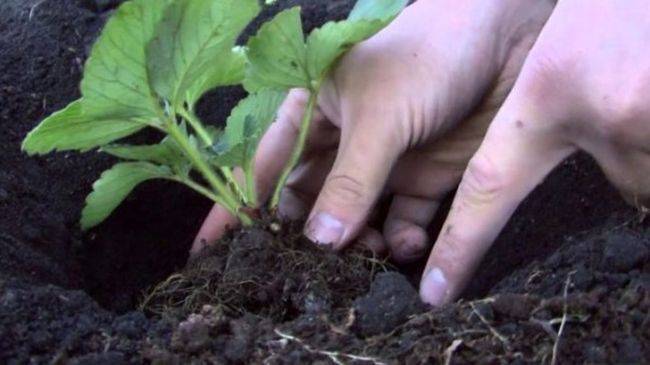

Soil renewal
If you have a small plot of land and from year to year you have to grow the same plant culture in one place, it is natural that the soil needs renewal (improvement). In the old earth, causative agents of fungal diseases accumulate, and the number of nutrients also decreases.
The whole secret of the renewal of the land lies in the enhanced cultivation of agricultural technology. For example, you can create recessed or raised beds by filling them with humus or compost. In such conditions, there is a partial replacement of the soil, microorganisms are intensively functioning, processing organic matter into a new soil. In addition, the berries are supplied with nutrients in abundance.


Plants can be protected from pests and diseases by health-improving soil treatment under the strawberries in the fall. Do not forget also that the beds need to be mulched from time to time. Mulch will serve as a barrier to the penetration of infections on the aerial parts of strawberry plants.
Care for remontant strawberries
The compulsory strawberry care includes:
- Fertilizing crops.
- Competent watering.
- Loosening of the soil followed by mulching.
- Pest control measures.
- Mustache trimming.
How to water strawberries
Strawberries of this variety need moisture more than regular berry crops. Watering cannot be ignored if it is + 30 ° C outside. At the time when the fruits ripen, the soil should be moistened by three centimeters, no less. Mulching can be done to retain moisture.
Soil loosening
After any moistening of the soil, it is necessary to loosen it. This will improve the condition of the root system, open access to oxygen. Only this must be done carefully so as not to damage the fragile antennae.
You can make your life easier and immediately carry out mulching with peat or dry grass. Then it will be possible not to loosen the strawberry beds, and the effect will be the same: a crust will not form on the ground, moisture will remain in the ground longer.
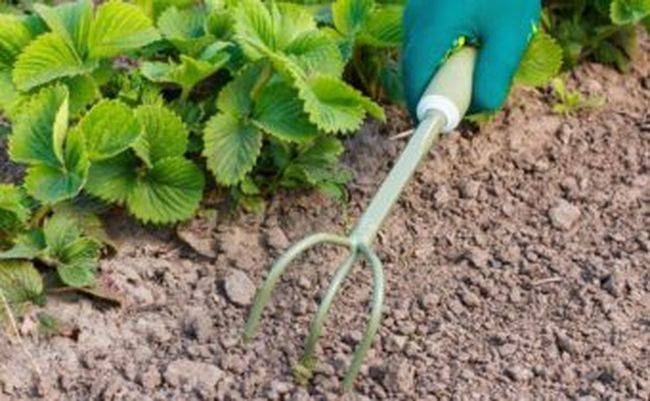

How to fertilize strawberries
Top dressing and fertilization can be carried out simultaneously with watering. And it is not necessary to use complex chemical compounds. Many gardeners use a natural infusion of nettle or bitter wormwood. The grass is crushed, poured with water and insisted for a week in the sun.
Watering with herbal infusion is useful for strawberries, since it contains a large amount of trace elements necessary for its development. You can additionally feed the strawberry bushes with bird droppings diluted with water in a ratio of 1:15. Cow dung can also be used, but you need to dilute it 1:10.
How to protect a plant
With improper autumn care for remontant strawberries, the culture can get sick. The most common cause is a fungal infection. Powdery mildew and brown spot infect strawberry leaves. In the cool season, gray rot develops. The affected areas must be removed, then sprayed with fungicides.
Of the pests, the strawberry mite appears most often on remontant strawberries. After harvesting the entire crop, it is necessary to spray the bushes with a solution of karbofos.
Mustache removal
The strawberry antennae must be removed regularly, otherwise the number of berries will sharply decrease, and the planting will be overgrown with a large number of shoots. You can leave only a few antennae for breeding, and the rest must be cut off for the winter.
Diseases
The susceptibility to infections in garden strawberries is very high. Insects are more often carriers of infection. Sometimes gardeners themselves infect the soil using low-quality fertilizers when transplanting seedlings to a new place that is affected by diseases.
Gray and black rot
The infection is spread by insects, wind. Rot spores overwinter on soil, plant debris. A strawberry affected by gray mold looks like this:
- Dark spots form on the fruit.
- Gradually decays completely.
- The rest of the fruits are covered with gray fluff. This is a sign of developing rot spores.
Important! If you find 1-2 berries that are sick with gray rot, carefully inspect the entire garden. Without regret, remove the infected fruits from the flower bed, remove them from the site and destroy them.
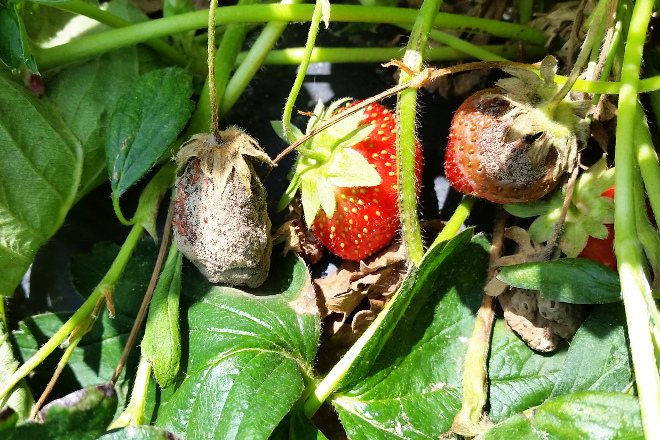

Powdery mildew
This is a fungal disease. The first signs of flour plaque appear on the petioles of the berries, on the lower part of the leaves. Shoots are covered with specks, a whitish cobweb.
The purpose of powdery mildew is to disrupt the vascular system of the leaves. The green parts of the bushes dry up, curl up into a tube, the fruits do not ripen, they lose juices.
Spores are easily carried by the wind and settle in the ground together with new seedlings. The fungus is capable of destroying huge strawberry plantations along with the harvest in a short period of time.
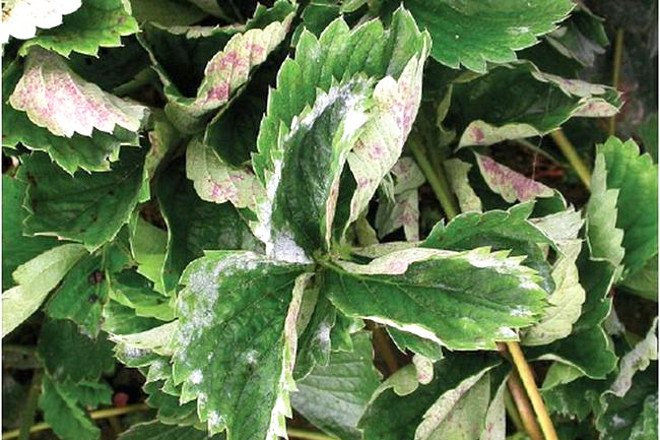

Brown and White Spot
This is the main disease of garden strawberries. White, brown spotting is capable of killing more than 50% of the deciduous mass during the active period of spore breeding.
You can recognize an infection by the following symptoms:
- Purple spots appear on the leaves.
- There is a white dot inside the spots.
- The leaves dry up, turning yellow quickly.
- The other organs of the culture are affected by spots: the stalk, berries, stems.
Important! The cause of spotting is dampness, plant debris in the flower bed, thickening of strawberry plantings.
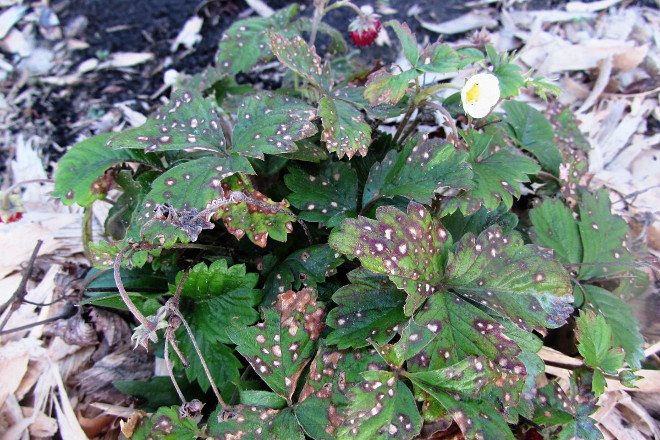

Black root rot
In another way, it is called rhizoctoniasis. The signs of the disease are as follows:
- Young shoots of Victoria do not grow.
- Empty areas with dead plants appear on the garden bed.
- The leaves turn brown.
- The roots of the plant are easily removed from the soil.
- The root shaft is cracked, the young roots are dry.
Important! Unfortunately, it is extremely difficult to treat diseases of garden strawberry even with chemicals. Therefore, in neglected situations, the most effective means of control is the destruction of infected shoots and transplanting the crop to healthy soil.


Preparatory work in the fall
For remontant strawberries, several winter months are a real challenge, especially if the winter is not very snowy. It is necessary in the fall to properly carry out all the work on preparing the berry culture for winter so that the strawberry rosettes do not freeze. Strawberries should meet winter with a sufficiently increased green mass. It will protect the buds of the plant from frost.
Gardeners need to check every bush. The root collar should not stick out from the ground, you need to sprinkle it with earth. At the end of summer, the land around the bushes is loosened, and then mulching is carried out.
If the winter is snowy, it will reliably cover all the bushes. But what if there is no snow at all? In this case, leaves or hay will become a shelter. Such materials will save the culture from frost, but they are not entirely convenient, they get wet from moisture, in the spring it is very difficult to clean the strawberry rosettes from them.
With frequent thaws and high humidity, the bushes can dry out. Another drawback is that mice like to hibernate under straw, they can damage the roots.
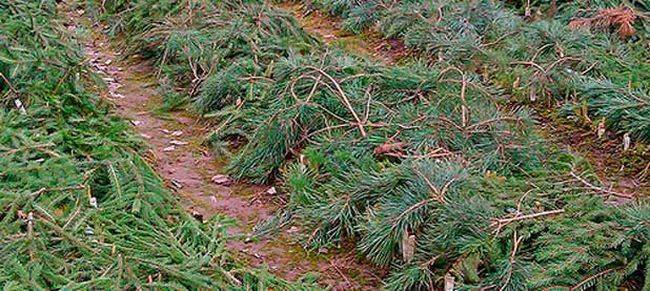

Shelter strawberries for the winter with straw
The use of straw as a frost protection for strawberries is practiced only among amateur gardeners with small strawberry plantations. It's a pretty good choice for small berry areas. Despite the low cost, good water and air permeability, such protection has many disadvantages.


Straw is only effective in regions where temperatures are stable in winter. In areas where thaws or periods of prolonged warming are often observed at this time, straw promotes the development of fungi and plant rot. In addition, this type of covering material is only suitable for one season (it must be replaced with a new one every year).
Note!
Straw is a material traditionally used for mulching strawberries. During the growing season, it protects it from weeds, and a thicker layer can be used as a shelter for the winter.
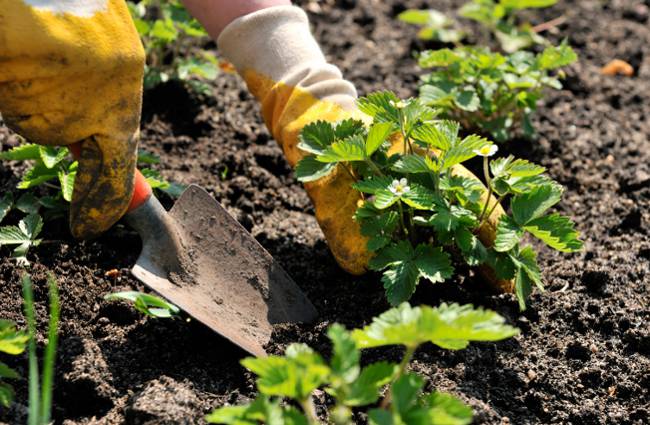

You may be interested in:
Transplanting strawberries in the fall: when to carry out and how to do it Many gardeners who left work on transplanting strawberries for the autumn period are interested in the question of when and at ... Read more ...
Watering after harvest and in autumn
Despite the fact that the strawberries have finished bearing fruit, watering should not be stopped, especially since the second half of July and August are the very height of summer, which is often arid. Watering should be done at least once every 7-10 days. Do not bring to the point that the plants themselves begin to "signal" the need for watering - the bushes will droop, and the foliage will dry out, but it is also impossible to pour until the bush is "locked".
Advice! After each watering, if you want the nutrient moisture to remain longer, the aisles should be loosened, and even better mulch.
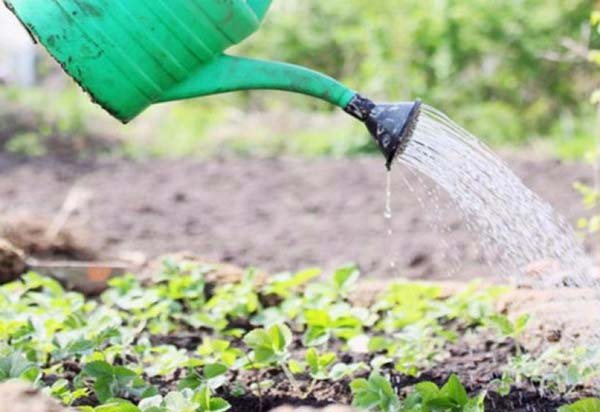

With the onset of autumn, if the rains begin, then you practically won't have to water yourself anymore, nature will do everything for you. But if the autumn turns out to be dry, you will have to moisturize the bushes on your own and regularly (after all, the laying of flower buds depends on this).
Important! Do not forget to do the autumn water-charging watering before the first frost.
Top dressing
Fertilization is another important step in how to care for strawberries in the fall. The plant responds well to organic nutrients: poultry (chicken) droppings, horse manure, mullein or humus. Also, gardeners often add wood ash (it is a good substitute for mineral fertilizing).
As for mineral fertilizers, you can use superphosphate or potassium salt.
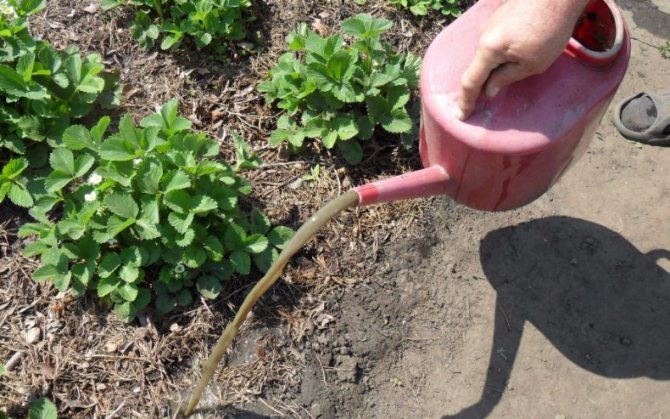

First, humus, mullein or horse manure are spread in small pieces over all the beds. Rains and planned irrigation will gradually dilute fertilizers, evaporating useful substances from them and delivering them deep into the soil, to the strawberry root system.
However, the method of feeding the beds with chicken droppings works much faster. For this purpose, fresh droppings are dissolved in water in a ratio of 1:20 and thoroughly mixed. Then the resulting liquid is poured under the berry bushes. Consumption for 7-10 bushes is approximately 1 bucket of composition. In the case of using mineral dressings, they are scattered over the site, sealed with a hoe in the ground. It is immediately necessary to water the beds. So that after moistening the soil, a crust does not form on its surface, the site is mulched with peat or needles. In the future, it will be possible to loosen the soil and water the plants through a layer of mulch.
Disease Prevention and Pest Control
Garden strawberries are often affected by fungal and other diseases, as well as various pests. Timely processing in the fall will prevent the appearance of insects and avoid infections.
On a note! Sick bushes are recommended to be dug up and burned along with foliage and shoots.


For prevention use:
- insecticides "Alatar", "Aktellik", "Karbofos";
- biological products "Fitoverm", "Aktofit";
- infusion of tomato tops (for 10 liters of boiling water - 1-2 kg of stepchildren and tomato leaves);
- dandelion infusion (1 kg of herbs per bucket of hot water).
The above remedies help against strawberry mites, weevils, aphids.
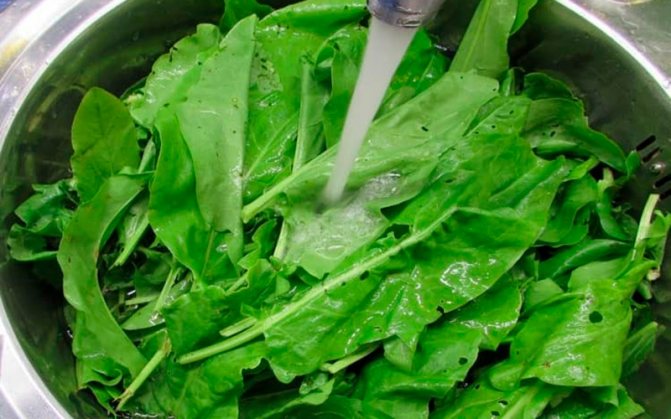

To prevent fungal infections, it is recommended to spray the plantings with an infusion of leaves and stems of horse sorrel (a bucket of sorrel leaves for a bucket of water, insist for 3 days), a solution of brilliant green (12-15 drops per 10-liter bucket of water). Do not forget about the treatment with Bordeaux mixture, copper oxychloride, preparations "Alirin", "Trichodermin", a solution of mustard powder.
Useful Tips
A few helpful tips from seasoned gardeners will tell you what to do with strawberries in the fall.
- Use horse sorrel to feed strawberries. Collect the grass, pour boiling water over and leave for 2-3 weeks, the path decomposes. Watering the entire garden with such fertilizer will bring incredible benefits.
- Observe the proportions when applying fertilizers, medicinal solutions. If the concentration is exceeded, the bushes will burn.
- Before transplanting Victoria to new sites, sow mustard powder on the soil of the future flower bed. It will increase the fertility of the land.
- To get the best possible yield, trim off any excess tendrils on the bushes. They take a lot of energy away from the culture.
- Use mulch in summer, spring. The cover reduces the growth of weeds.
- Sprinkling sawdust on the soil under strawberry seedlings is possible on leached chernozems, on acidic soils it gives the opposite result.
Now you know exactly what to do with garden strawberries in autumn, you can increase yields, show off to your neighbors and friends about a neat berry plantation. Turn the grooming process for Victoria into an annual routine. In this case, growing garden strawberries will seem simple and interesting.
Preparing a strawberry garden for winter. When to start preparing for winter by region
The goal of the gardener should be to prepare the strawberry bushes in advance for winter. Indeed, after pruning or transplanting, plants need time to recover and adapt. They must have time to come to their senses, release new shoots and grow roots, so work cannot be carried out just before the frosts. The specific timing of the preparatory work depends on the region. Additionally, you need to pay attention to what the weather is like.
In outskirts of Moscow


The more time the strawberries have to recover, the better.Even if autumn spoils with warm weather, it is best to finish pruning the berries and process them in early September. Let the plants gain strength before sheltering for the winter, because fruiting seriously depletes the berries, especially for remontant varieties.
In the Urals


The peculiarity of the Ural climate is the unpredictability of the weather and the early probability of frost. It is not recommended to mow strawberries here for the reason that they will not have time to recover before the arrival of frost. When the berry is left without leaves, flower buds are laid reluctantly and the yield may decrease the next year. In the event that the plants are affected by ticks and fungal diseases, the leaves are cut a month earlier than in the Moscow region, that is, in July.
In Siberia
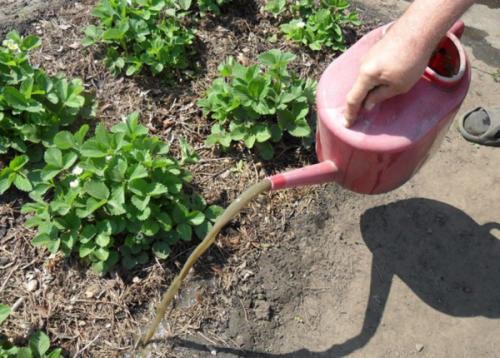

In the conditions of the short Siberian summer, strawberries of early maturing varieties are grown and they begin to prepare them for winter immediately after harvesting. In early August, the old lower leaves and the remaining peduncles are removed from the plants. It is also necessary to remove from under the bushes the old mulch in which the gray mold spores have settled. Pruning is not carried out on young and healthy bushes. In the fall, they only feed and water the plants so that they continue to develop in the time remaining until winter.
In the Leningrad region
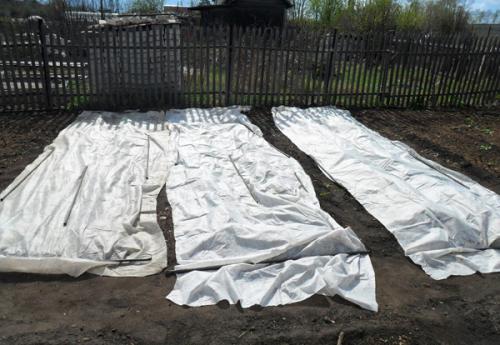

In the Leningrad region, rainy autumn is most often, so it is better to mow the bushes in August. In conditions of high humidity, fungal diseases and rot develop at an enormous rate. If you leave the foliage on the bushes, in the spring the strawberries will be affected by numerous diseases, the harvest will be of poor quality. It will be necessary to cover the plants after the ground is frozen. On the eve of this event, the ridge is cleaned from old plants, dried peduncles and excess mustaches.
Snails and slugs
Snails and slugs are not easy to get out. But if you systematically fight them, they will definitely leave the site. To begin with, you should use the mechanical method. They are simply harvested by hand as they emerge. It is best to do this in a cool time, when they crawl out of their shelters.


The slug not only spoils the leaves, but also eats strawberries
When mechanical cleaning does not work, insecticides can be used. During the autumn processing of strawberries, the insecticide "Metaldehyde" is used. He copes well with snails, slugs. Plants are not sprayed with them, but simply scattered granules around the bushes, where these pests most often appear.
Strawberry pruning: when to do it - after fruiting or in the fall
The opinions of gardeners about whether to trim the leaves of strawberries in the fall are often not the same.
Many gardeners, taught by the old rules, are accustomed to pruning strawberry leaves in the fall, straightening bare bushes for the winter.
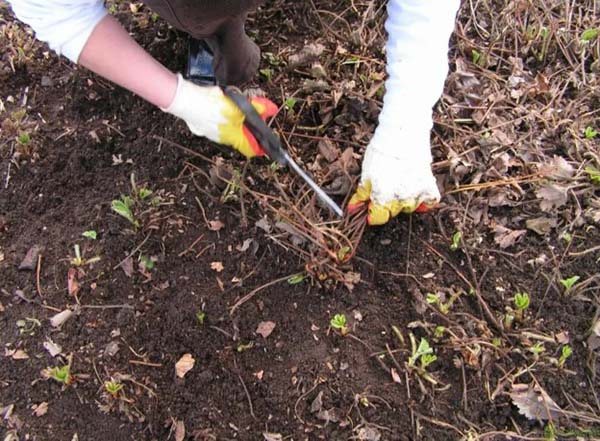

Others - quite rightly believe that strawberry bushes should not be freed from foliage before wintering.
Why! If you cut off the entire leafy cover completely, then the plant will experience real stress and will direct all its strength to restore green mass. This process will noticeably weaken the shrub, depriving the forces that should have been directed at the formation of peduncles - the laying of the future harvest. It turns out that such unnecessary and untimely pruning of strawberries in the fall will potentially reduce the amount of harvest you will receive in the spring.
Moreover, lush leaves are the strawberry's natural hiding place, which saves her from freezing in winter.
When and how best to prune strawberries
According to experienced gardeners, it is most correct to carry out the pruning procedure after fruiting and picking berries, in other words, in the second half of July and early August. Later dates for pruning strawberries are strictly prohibited.
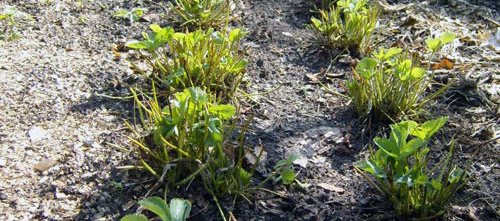

There is also an opinion that pruning can be postponed until late August or early September, and minor stress will only stimulate the future laying of fruit stalks.However, it is still better to adhere to the time-tested opinion of experienced gardeners.
Video: how to properly trim strawberries after harvest
Spring pruning
One pruning after fruiting strawberries is not enough, you will have to prune in the spring. After the first spring sun warms up, and the strawberries start to grow, at this moment they should be carefully examined and dealt with. recovery after winter and spring care.
With regard to pruning, in the spring are subject to removal:
- dead stems;
- frozen leaves;
- foliage creeping on the ground - it has outlived itself;
- if there is a damaged part on the greens, then this leaf is also completely removed.
By the way! More information on spring pruning strawberries you'll find here.
Loosening and weeding
Once you've pruned the strawberries, it's time to weed well and loosen up the soil between the rows so that the roots of the plant get enough oxygen.


Advice! When loosening a strawberry bed, you should not get too close to the root system, which is located quite superficially, it is better to retreat from the base of the plant by 12-15 centimeters.
After loosening, add additional fresh soil under the bushes. This is necessary due to the fact that during summer growth, the roots crawl out. Subsequently, an excessively bare root can cause the bush to freeze out in winter and reduce the yield in the next season.
Pest control
Before sheltering the bushes for the winter, the beds are treated with drugs against pests and fungi. To do this, you can use Bordeaux liquid, which is sold in stores.
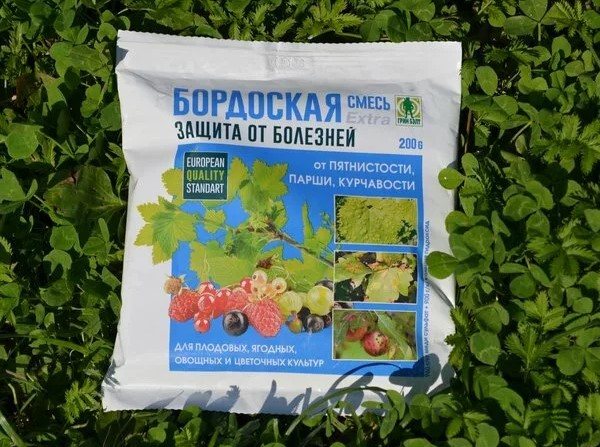

A solution of brilliant green is also suitable, which is prepared from 10-15 drops of a pharmacy product and 10 liters of water. Ammonia can be used as a disinfectant. It will take 3-4 tablespoons per 10 liter bucket.
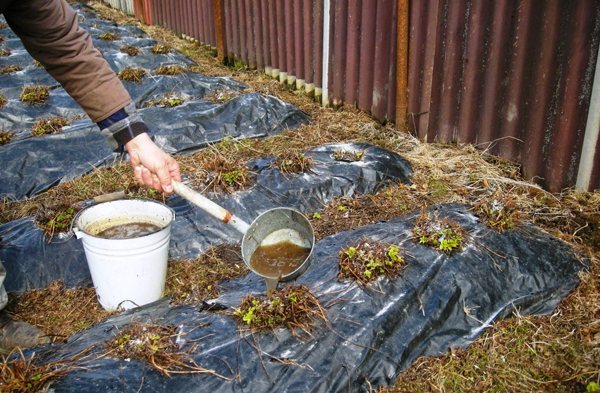

In the fall, even strong insecticides can be used, since the harvest has already been harvested. Also, modern means against pests are suitable, which help not only to fight dangerous diseases and insects, but also help to strengthen the immunity of plants.
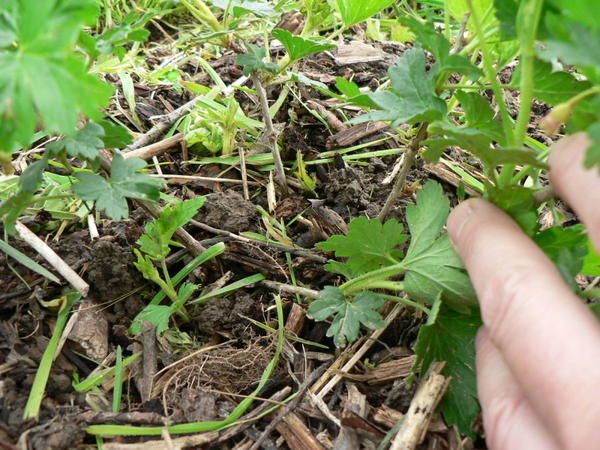

How can you feed garden strawberries
You will be surprised if you find out that fertilizing the soil allows the crop to winter better.:
- Fertilizers improve the composition of the soil;
- The earth becomes looser, and this is very important for the growth of the root system;
- The plant's resistance to pests and diseases increases.
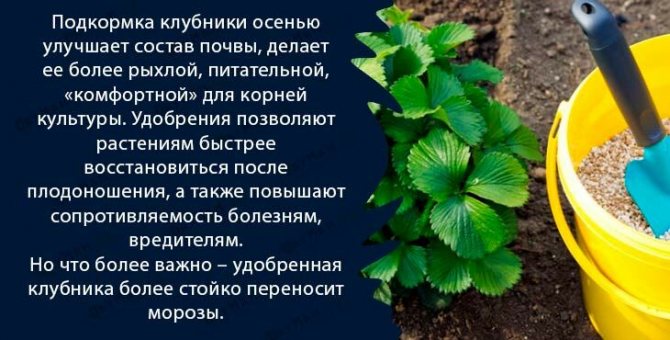

Then it's worth finding out how to feed your garden strawberries in the fall!
- Wood ash. In the form of a dry product 150g per 1sq.m. land. In the form of an infusion (2 tablespoons per 1 liter of hot water; boil for 15 minutes. Mix this infusion in 10 liters of water and apply).
- Biohumus. Dilute and water the soil, not the plants !!!
- Chicken droppings. 500 g of dry litter is diluted in 10 liters of water. Infused for 2-10 days. And then you can water. But it's better not to get it on the bushes with this top dressing.
- Humus. In dry form, humus is scattered between the bushes, and after 5-7 days the earth is loosened. In liquid - 1 kg per 10 liters of water is stirred. After 2 days, this infusion can be watered.
- Bean siderat, lupine stalks, cut grass are crushed, laid out between bushes and crushed by the ground. Liquid grass and weed fertilizer can be used.
These dressings will strengthen the plants and help it overwinter.
Agrotechnical cultivation
All varieties of garden strawberries available today to gardeners and gardeners can be divided into two groups:
Despite serious differences in the mode of their vegetation, the methods of cultivation and care for each of the species are similar in many respects, because, in fact, these plants are the closest relatives. However, in this material we will not talk at all about general features, but on the contrary, about the differences that must be taken into account in order to obtain a solid harvest.
On average, the number of fruiting remontant berries in one season is equal to two units, however, subject to certain conditions, the harvest can be obtained 3, or even all 4 times. The final amount will depend on when the so-called fruit barrels are laid in plants.
So, an ordinary garden berry, the process of forming the mentioned barrels produces only during that period of the year when the daylight hours becomes short, that is:
- at the end of the summer season;
- at the beginning of autumn.
The repaired plant variety successfully carries out this process:
- during a long daylight period (budding at a temperature of + 15 ° C and a day length of 14-17 hours);
- in the period of neutral daylight hours (laying the kidneys by periods, every 5-6 weeks at a temperature from +2 to + 30 ° C).
A strawberry of neutral daylight hours must be present in every berry lover, since in the conditions of a "failed" season, which is not so rare due to the severity and unpredictability of climatic conditions in Russia, an ordinary strawberry may not bear fruit, but the mentioned remontant variety with comfort will continue to gain the ovary. And it will continue to do this until the onset of frost.
The second harvest of traditional remontant strawberries is the most abundant, depending on the age of each bush, it can account for up to 90% of the total harvest harvested during the growing season.
Note: unfortunately, remontant strawberries, especially actively bearing fruit in a particular season, may not withstand the load and die off by autumn. You need to know this feature, and be ready to replace obsolete bushes with new ones.
Another interesting feature of remontant strawberries is that they can form fruits:
- on maternal plants;
- young rooted mustache.
This is a great opportunity to get more berries than you expected, however, provided that the beds are covered with garden film, the mustache will have to punch the road in the literal sense: making holes in the fabric.
What is a remontant strawberry and how is it different from a traditional garden berry
First, let's understand the meaning of the word "remontant". This term refers to garden plants that have the ability to bear fruit multiple times during one growing season.
So, in this case we are talking about strawberries, however, some varieties are also characterized by a similar high yield:
- strawberries;
- raspberries;
- home flowers (multiple flowering);
- other garden plants.
Strawberry is a large-fruited berry, which we are all accustomed to designating that way, however, if we talk about its scientific name, then in this material we will talk about large-fruited garden strawberry. Nevertheless, for ease of understanding, we will focus on the designation "strawberry".
Why process strawberries in the fall?
Healthy strawberries yield a bountiful harvest, quality berries, ready to be processed or sold. But even if the bushes did not hurt in the spring and summer, they can be affected in the fall, because pests are hiding at this time for the winter, and strawberry bushes are quite a suitable place for them. At the same time, strong winds and frequent rains are favorable weather for the multiplication of fungal and viral diseases.
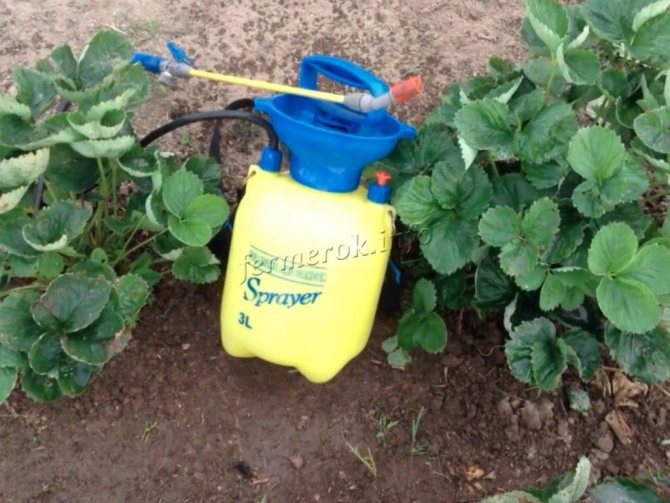

Photo of strawberry processing in autumn
Important!
In the summer, you need to carefully monitor what the strawberries were sick with, what pests affected it, in order to use drugs for those pests and diseases that are on the site in the fall. Thus, processing strawberries in the fall will be more effective and beneficial.
Autumn processing of strawberries is aimed at destroying all pests that are hiding in the axils of strawberry leaves, at the root system, as well as diseases that have already settled on them.


